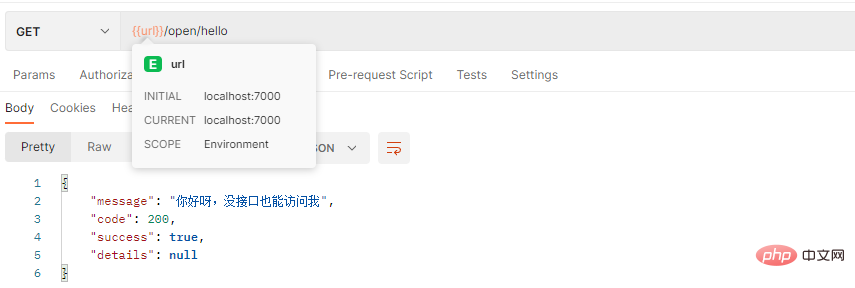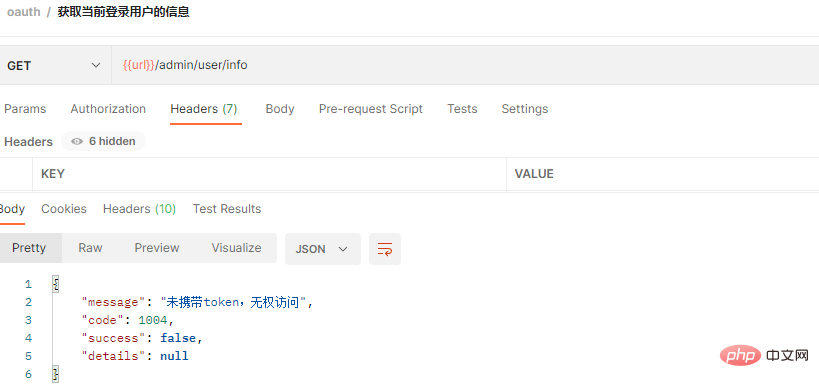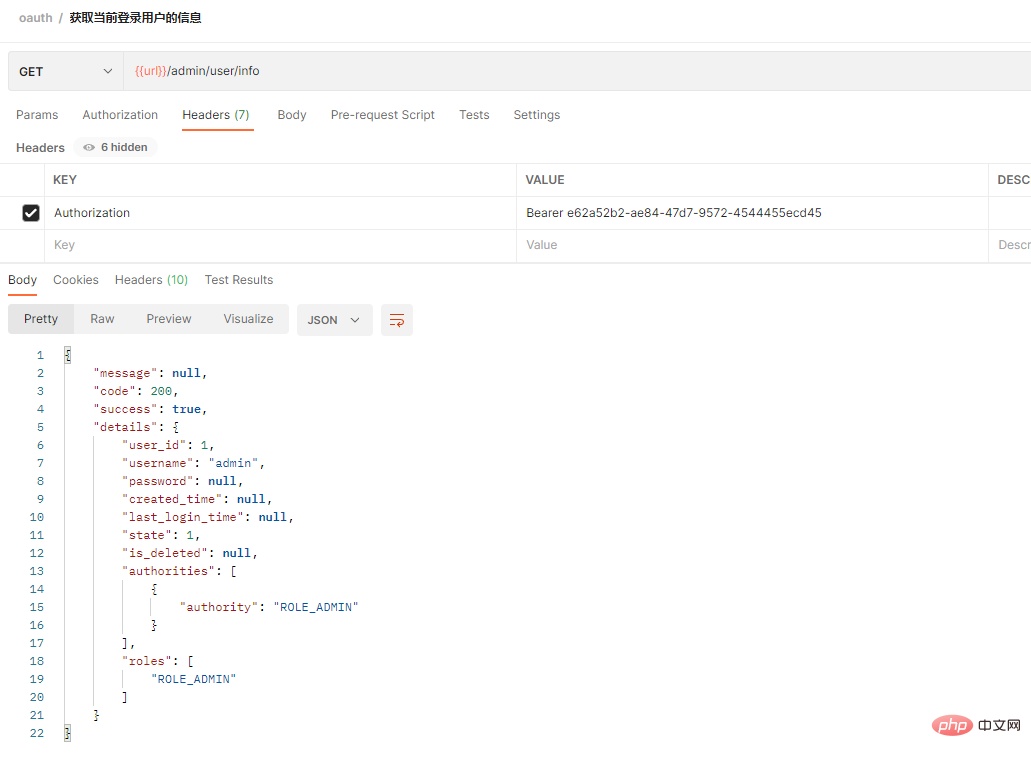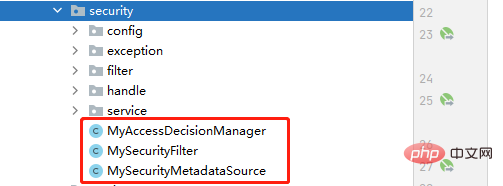SpringBoot怎麼整合SpringSecurityOauth2實現鑑權動態權限問題
準備
spring-boot:2.1.4.RELEASE
spring-security-oauth3:2.3.3.RELEASE(如果要使用原始碼,不要隨意改動這個版本號,因為2.4往上的寫法不一樣了)
mysql:5.7
效果展示
這邊只用了postman做測試,暫時未使用前端頁面來對接,下個版本角色選單權限指派的會有頁面的展示
1、存取開放介面http://localhost:7000/open/hello

2 、不帶token訪問受保護介面http://localhost:7000/admin/user/info

3、登入後取得token,帶上token訪問,成功返回了目前的登入使用者資訊


#oauth3一共有四種模式,這邊就不做講解了,網上搜一搜,千篇一律
因為現在只考慮做單方應用的,所以使用的是密碼模式。
後面會出一篇SpringCloud Oauth3的文章,網關鑑權
來講幾個點吧
1、攔截器配置動態權限

新建一個MySecurityFilter類,繼承AbstractSecurityInterceptor,並實作Filter介面
初始化,自訂存取決策管理器
@PostConstruct
public void init(){
super.setAuthenticationManager(authenticationManager);
super.setAccessDecisionManager(myAccessDecisionManager);
}自訂過濾器呼叫安全元數據來源
@Override
public SecurityMetadataSource obtainSecurityMetadataSource() {
return this.mySecurityMetadataSource;
}先來看看自訂篩選器呼叫安全性元資料來源的核心程式碼
#以下程式碼是用來取得到目前請求進來所需的權限(角色)
/**
* 获得当前请求所需要的角色
* @param object
* @return
* @throws IllegalArgumentException
*/
@Override
public Collection<ConfigAttribute> getAttributes(Object object) throws IllegalArgumentException {
String requestUrl = ((FilterInvocation) object).getRequestUrl();
if (IS_CHANGE_SECURITY) {
loadResourceDefine();
}
if (requestUrl.indexOf("?") > -1) {
requestUrl = requestUrl.substring(0, requestUrl.indexOf("?"));
}
UrlPathMatcher matcher = new UrlPathMatcher();
List<Object> list = new ArrayList<>(); //无需权限的,直接返回
list.add("/oauth/**");
list.add("/open/**");
if(matcher.pathsMatchesUrl(list,requestUrl))
return null;
Set<String> roleNames = new HashSet();
for (Resc resc: resources) {
String rescUrl = resc.getResc_url();
if (matcher.pathMatchesUrl(rescUrl, requestUrl)) {
if(resc.getParent_resc_id() != null && resc.getParent_resc_id().intValue() == 1){ //默认权限的则只要登录了,无需权限匹配都可访问
roleNames = new HashSet();
break;
}
Map map = new HashMap();
map.put("resc_id", resc.getResc_id());
// 获取能访问该资源的所有权限(角色)
List<RoleRescDTO> roles = roleRescMapper.findAll(map);
for (RoleRescDTO rr : roles)
roleNames.add(rr.getRole_name());
}
}
Set<ConfigAttribute> configAttributes = new HashSet();
for(String roleName:roleNames)
configAttributes.add(new SecurityConfig(roleName));
log.debug("【所需的权限(角色)】:" + configAttributes);
return configAttributes;
}再來看一下自訂存取決策管理器核心程式碼,這段程式碼主要是判斷目前登入使用者(目前登入使用者所擁有的角色會在最後一項寫到)是否擁有該權限角色
@Override
public void decide(Authentication authentication, Object o, Collection<ConfigAttribute> configAttributes) throws AccessDeniedException, InsufficientAuthenticationException {
if(configAttributes == null){ //属于白名单的,不需要权限
return;
}
Iterator<ConfigAttribute> iterator = configAttributes.iterator();
while (iterator.hasNext()){
ConfigAttribute configAttribute = iterator.next();
String needPermission = configAttribute.getAttribute();
for (GrantedAuthority ga: authentication.getAuthorities()) {
if(needPermission.equals(ga.getAuthority())){ //有权限,可访问
return;
}
}
}
throw new AccessDeniedException("没有权限访问");
}2、自訂鑑權異常回傳通用結果
為什麼需要這個呢,如果不配置這個,對於前端,後端來說都很難去理解鑑權失敗回傳的內容,還不能統一解讀,廢話不多說,先看看不配置和配置了的返回情況
(1)未自定義前,沒有攜帶token去訪問受保護的API接口時,返回的結果是這樣的

(2)我們規定一下,鑑權失敗的介面回傳介面之後,變成下面這種了,是不是更利於我們處理和提示使用者

好了,來看看哪裡去設定的吧
我們資源伺服器OautyResourceConfig,重寫下下面這部分的程式碼,來自訂鑑權異常回傳的結果
大夥可以參考下這個https://www.yisu.com/article/131668.htm
@Override
public void configure(ResourceServerSecurityConfigurer resources) throws Exception {
resources.authenticationEntryPoint(authenticationEntryPoint) //token失效或没携带token时
.accessDeniedHandler(requestAccessDeniedHandler); //权限不足时
}
protected User user;
public SecurityUser(User user) {
this.user = user;
}
public User getUser() {
return user;
}protected User getUser() {
try {
SecurityUser userDetails = (SecurityUser) SecurityContextHolder.getContext().getAuthentication()
.getPrincipal();
User user = userDetails.getUser();
log.debug("【用户:】:" + user);
return user;
} catch (Exception e) {
}
return null;
}
@Service
public class TokenUserDetailsService implements UserDetailsService{
@Autowired
private LoginService loginService;
@Override
public UserDetails loadUserByUsername(String username) throws UsernameNotFoundException {
User user = loginService.loadUserByUsername(username); //这个我们拎出来处理
if(Objects.isNull(user))
throw new UsernameNotFoundException("用户名不存在");
return new SecurityUser(user);
}
}
@Override
protected void configure(AuthenticationManagerBuilder auth) throws Exception {
auth.userDetailsService(userDetailsService).passwordEncoder(passwordEncoder());
}@Override
public User loadUserByUsername(String username){
log.debug(username);
Map map = new HashMap();
map.put("username",username);
map.put("is_deleted",-1);
User user = userMapper.findByUsername(map);
if(user != null){
map = new HashMap();
map.put("user_id",user.getUser_id());
//查询用户的角色
List<UserRoleDTO> userRoles = userRoleMapper.findAll(map);
user.setRoles(listRoles(userRoles));
//权限集合
Collection<? extends GrantedAuthority> authorities = merge(userRoles);
user.setAuthorities(authorities);
return user;
}
return null;
}
以上是SpringBoot怎麼整合SpringSecurityOauth2實現鑑權動態權限問題的詳細內容。更多資訊請關注PHP中文網其他相關文章!

熱AI工具

Undresser.AI Undress
人工智慧驅動的應用程序,用於創建逼真的裸體照片

AI Clothes Remover
用於從照片中去除衣服的線上人工智慧工具。

Undress AI Tool
免費脫衣圖片

Clothoff.io
AI脫衣器

Video Face Swap
使用我們完全免費的人工智慧換臉工具,輕鬆在任何影片中換臉!

熱門文章

熱工具

記事本++7.3.1
好用且免費的程式碼編輯器

SublimeText3漢化版
中文版,非常好用

禪工作室 13.0.1
強大的PHP整合開發環境

Dreamweaver CS6
視覺化網頁開發工具

SublimeText3 Mac版
神級程式碼編輯軟體(SublimeText3)
 解決kernel_security_check_failure藍色畫面的17種方法
Feb 12, 2024 pm 08:51 PM
解決kernel_security_check_failure藍色畫面的17種方法
Feb 12, 2024 pm 08:51 PM
Kernelsecuritycheckfailure(內核檢查失敗)就是一個比較常見的停止代碼類型,可藍屏錯誤出現不管是什麼原因都讓很多的有用戶們十分的苦惱,下面就讓本站來為用戶們來仔細的介紹一下17種解決方法吧。 kernel_security_check_failure藍色畫面的17種解決方法方法1:移除全部外部裝置當您使用的任何外部裝置與您的Windows版本不相容時,則可能會發生Kernelsecuritycheckfailure藍色畫面錯誤。為此,您需要在嘗試重新啟動電腦之前拔下全部外部裝置。
 編程新範式,當Spring Boot遇上OpenAI
Feb 01, 2024 pm 09:18 PM
編程新範式,當Spring Boot遇上OpenAI
Feb 01, 2024 pm 09:18 PM
2023年,AI技術已成為熱門話題,對各行業產生了巨大影響,程式設計領域尤其如此。人們越來越認識到AI技術的重要性,Spring社群也不例外。隨著GenAI(GeneralArtificialIntelligence)技術的不斷進步,簡化具備AI功能的應用程式的創建變得至關重要和迫切。在這個背景下,"SpringAI"應運而生,旨在簡化開發AI功能應用程式的過程,使其變得簡單直觀,避免不必要的複雜性。透過"SpringAI",開發者可以更輕鬆地建立具備AI功能的應用程序,將其變得更加易於使用和操作
 利用Spring Boot以及Spring AI建構生成式人工智慧應用
Apr 28, 2024 am 11:46 AM
利用Spring Boot以及Spring AI建構生成式人工智慧應用
Apr 28, 2024 am 11:46 AM
Spring+AI作為行業領導者,透過其強大、靈活的API和先進的功能,為各種行業提供了領先性的解決方案。在本專題中,我們將深入探討Spring+AI在各領域的應用範例,每個案例都將展示Spring+AI如何滿足特定需求,實現目標,並將這些LESSONSLEARNED擴展到更廣泛的應用。希望這個專題能對你有所啟發,更深入地理解和利用Spring+AI的無限可能。 Spring框架在軟體開發領域已經有超過20年的歷史,自SpringBoot1.0版本發布以來已有10年。現在,無人會質疑,Spring
 spring編程式事務有哪些實作方式
Jan 08, 2024 am 10:23 AM
spring編程式事務有哪些實作方式
Jan 08, 2024 am 10:23 AM
spring編程式事務的實作方式:1、使用TransactionTemplate;2、使用TransactionCallback和TransactionCallbackWithoutResult;3、使用Transactional註解;4、使用TransactionTemplate和@Transactional結合使用;5、自訂事務管理器。
 SpringBoot與SpringMVC的比較及差別分析
Dec 29, 2023 am 11:02 AM
SpringBoot與SpringMVC的比較及差別分析
Dec 29, 2023 am 11:02 AM
SpringBoot和SpringMVC都是Java開發中常用的框架,但它們之間有一些明顯的差異。本文將探究這兩個框架的特點和用途,並對它們的差異進行比較。首先,我們來了解一下SpringBoot。 SpringBoot是由Pivotal團隊開發的,它旨在簡化基於Spring框架的應用程式的建立和部署。它提供了一種快速、輕量級的方式來建立獨立的、可執行
 Spring如何設定事務隔離級別
Jan 26, 2024 pm 05:38 PM
Spring如何設定事務隔離級別
Jan 26, 2024 pm 05:38 PM
Spring設定事務隔離等級的方法:1、使用@Transactional註解;2、在Spring設定檔中設定;3、使用PlatformTransactionManager;4、在Java配置類別中設定。詳細介紹:1、使用@Transactional註解,在需要進行事務管理的類別或方法上加入@Transactional註解,並在屬性中設定隔離等級;2、在Spring設定檔等等。
 Spring註解大揭秘:常用註解解析
Dec 30, 2023 am 11:28 AM
Spring註解大揭秘:常用註解解析
Dec 30, 2023 am 11:28 AM
Spring是一個開源框架,提供了許多註解來簡化和增強Java開發。本文將詳細解釋常用的Spring註解,並提供具體的程式碼範例。 @Autowired:自動組裝@Autowired註解可以用於自動組裝Spring容器中的Bean。當我們在需要依賴的地方使用@Autowired註解時,Spring將會在容器中尋找匹配的Bean並自動注入。範例程式碼如下:@Auto
 詳解Spring中的Bean取得方式
Dec 30, 2023 am 08:49 AM
詳解Spring中的Bean取得方式
Dec 30, 2023 am 08:49 AM
Spring中Bean取得方式詳解在Spring框架中,Bean的取得是非常重要的一環。在應用程式中,我們經常需要使用依賴注入或動態來取得Bean的實例。本文將詳細介紹Spring中Bean的取得方式,並給出具體的程式碼範例。透過@Component註解取得Bean@Component註解是Spring框架中常用的註解之一。我們可以透過在類別上新增@Compone






